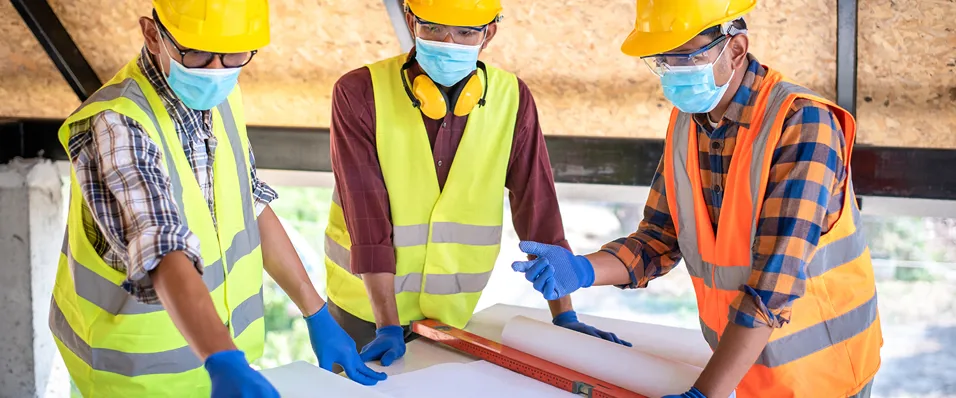
COVID-19 and how it has changed the way we work
Introduction
It has been a little while since my last WM article. One would think that with the impact of COVID 19, we would have had much more time to write articles. In stark contrast to this assumption, I have been extremely busy – and speaking with colleagues across the industry, it appears that I am not alone.
In this article, I will talk about some of the effects that COVID 19 has had on our industry and on us as individuals.
I received notification from the IET in February that, due to the pandemic, I was not to return to the office to work until further notice. This was not too much of an inconvenience as, like many others, I tended to work from home once or twice a week anyway. However, a lack of equipment did present some challenges at times.
It is now late October: there have been ups and downs, trials and errors, and I have experienced a very different way of working. I suspect we are not near the end yet.
In this article, I want to move away from some of the technical and educational content that I have written about in the past and focus on how COVID 19 and the restrictions have impacted on the daily working life of those of us on the standards side of the industry – addressing both the good and the bad points.
Working from home

I am a family man and, when I moved to the IET in 2014, one of my concerns was that my work would take over valuable time with my family. Fortunately, it worked out well; with the odd late night here and there, and some days away on business, I found a good work/life balance. Over the last eight months, during the lockdown, I have never spent so much time with my family! We have had breakfast together, lunch together and dinner together – and I am still clocking up more working hours than I was pre-COVID 19, due to not having to commute to London and the office regularly.
There are both positive and negative aspects to working from home, for me and others, which I discuss below.
Positive aspects of working from home

Less commuting, more family time
For many of us, a reduction in time spent commuting offers the opportunity to spend much more time with our families. This helps to maintain a healthier state of mind and, for those with young children, means that we don’t miss out on some of those irreplaceable moments of watching them grow.
Financial and environmental benefits
There have also been some financial benefits: many of us haven’t had to pay for planes, trains, buses and fuel to the same degree – all costs that can account for a significant amount of some people’s income. This in turn has given us some extra spending money to do the things we most enjoy, to help us through lockdown. With respect to the reduction in travel and commuting, there is also a positive impact on the environment, due to reduced emissions.
Downsides of working from home
Let’s now consider some of the challenges people may have experienced with working from home.

Health and wellbeing
Home, for most people, is a place of refuge to return to and switch off after a busy day on site or at the office. When your home becomes your place of work, switching into and out of work mode can be challenging.
In addition, home life isn’t always that easy for every family or individual, and the working day for some is seen as a relief. The commute provides time to read a book or catch up on emails – day-to-day work activities that take the mind off domestic worries and concerns.
Space
Some people are fortunate enough to have a spare room, home office or even a shed at the bottom of their garden from which they can work, providing at least a little separation between work and home life.
When you are living in smaller accommodation, or in a flat with several other residents, working from home can be much more difficult. The dining table becomes a multi-purpose venue, changing from office desk to dining table at breakfast, lunch and dinner (not to mention a repository for the craft projects the kids have left there from the evening before).
Getting space, peace and quiet to work can be impossible for some, especially as partners and children are also likely to be off work and school. There are many couples that both need to work from home (and many with children attempting online schooling at the same time), and so the battle for the best spot in the house for space and decent WiFi commences.
Screentime
When I began working from home during the lockdown, I found myself spending hours at a time in front of my screen. Gradually, I have managed to discipline myself to take regular breaks, even if just to stand in my garden for five minutes (usually as long as I can bear looking at the grass that is in desperate need of mowing). I have spoken to many people who find themselves spending hours in front of their screen and often missing lunch. This can have a serious detrimental impact on health and wellbeing, and it is essential that regular breaks are taken. Most, if not all, employers understand this, and individuals should not be put under pressure to spend more time than is recommended in front of a screen.
The HSE provides some free guidance on the use of display screen equipment, advising that regular breaks of 5-10 minutes every hour are far more beneficial than a break of, say, 20 minutes every 2 hours.
Equipment and resources

Items such as desktop computers, printers, shredders, webcams, books and publications, etc. are generally provided by employers. To ensure that employees can continue to work efficiently from home, it is essential that adequate equipment is provided and that it is possible to gain access to the workplace to pick up these essential items. The IET has a schedule in place to allow employees to access the office for this purpose while conforming to government guidance with respect to social distancing.
Restricted travel and the rise of web meetings
Travel restrictions have had a significant impact on the standards-setting world. Experts at a national and international level have been affected by company restrictions on travel since early March, making it necessary to cancel many meetings even before government restrictions prevented them from taking place.
These physical meetings have been replaced by web-based meetings with reduced agendas. As a result, the standards development process has slowed somewhat – although it is not the case that our workload has decreased; in fact, quite the opposite. Many of us involved in standards development, at the IET, IEC and CENELEC, have found that our workload has risen significantly, as we learn about and adapt to the challenges of working remotely in developing standards and guidance.
The first of the most significant meetings to be cancelled was the IEC TC 64 Plenary meeting scheduled to be held in May in Santiago, Chile. Shortly after cancellation, a one-day web meeting was arranged with a significantly reduced agenda. This essentially meant that only items of the utmost importance were discussed.
The meeting in Santiago was originally scheduled to take place over four days, with a very full agenda. The web meeting was reasonably successful, but it was clear to members that it would have been impossible to deal with some of the original agenda items via this type of meeting, due to the complexity of the technical discussions required. The web meeting was attended by more than 60 members from over 25 countries. During the meeting, we managed to cover subjects such as change of convenorships, progress reports and policy updates; however, all the other items are still outstanding. They will be discussed as soon as another meeting date and location have been agreed: the work does not go away but will remain until such time as the committee is able to meet again.
Web meetings: positive and negative aspects

There are both positive and negative aspects of web meetings. The following points are based on my own experience, as well as the opinions of colleagues.
- Lack of emotion
Although we all work at a professional level, there is a lot to be said for being in a room when someone is expressing their point of view and there is an emotive purpose. They may have a story to tell that has brought them to the opinion that they have. During a web meeting, it is very difficult to get this story across to other members and the argument may not be as well-received as it would at a physical meeting.
- On display
It may come naturally to many people nowadays, but there are still many who just don’t like to be the centre of attention! When you begin to speak at a web meeting, whether from a live video feed or a name on the screen, you are very much on display and the focal point of everyone at the meeting. This is obviously true to a certain extent at physical meetings as well, but there, less confident speakers may feel more comfortable, as they can merge in with their surroundings and witness people’s reactions to what they are saying. On a web meeting, such speakers can be overly conscious of the fact that they are at the centre of the other participants’ screens, and they are not able to see how others respond to what they say.
- Staring at a screen
The HSE suggests that short, frequent breaks are more satisfactory than occasional, longer breaks. This is often quite challenging when in a web meeting. I have participated in a few meetings that have stopped every hour or so, but it is very easy to get carried away, and before you know it, you have spent two hours staring at a screen, concentrating intently on the discussion, while taking notes. I have found myself suffering from a headache and feeling lethargic after exceptionally long web meetings. Some organizers are starting to appreciate the challenges with regard to looking at a screen for long periods of time and have introduced regular breaks. This, however, also has its difficulties, as the flow of the meeting is then interrupted and discussions may be extended longer than is necessary.
- Connection issues
Connectivity, or interruption of connectivity, can be extremely frustrating when participating in web meetings. Difficulties often begin as soon as a meeting commences, with interruptions of “Can you hear me? See me? I can hear you”, which can go on for some time. It can be even more frustrating when you are in mid-flow, making a very strong argument for something you believe in, and the Chair interrupts: “Sorry, we lost you just after you started speaking; can you take it from the top again?”. I have begun to make assessments of how much time is spent and wasted dealing with connection issues (my own or those of others) and have arrived at a period of around 15-30 minutes per meeting.
- Time restrictions
As mentioned earlier, there are recommended time durations from the HSE with regard to staring at screens. This, in addition to common sense, has meant that meetings are rarely held for more than two hours at a time. In many international meetings, timings are scheduled for two hours in the morning and two in the afternoon, over a three-day period. The timing of an international meeting also has to take into consideration the different time-zones from which committee members are joining.
Not long ago I experienced an international meeting that took place via the web and lasted for three days in this fashion, covering two hours every morning and afternoon. I, and several other members who attended, found this quite exhausting, especially those who were participating online from Mexico, with a 3am start.
- Accessibility
On a positive note, and one that covers quite a wide spectrum of advantages, one of the best aspects of web meetings is their accessibility to members. At a national level, our technical committee members travel from all over the UK to attend meetings, which are usually held in London, and this at times can place quite a burden on our experts. Having the option to join a meeting remotely provides those who may otherwise not be able to attend with the opportunity to contribute to the discussions. I have managed several meetings in the past where two or three participants have joined via web conference, and this has worked reasonably well. However, it must be noted that these members regularly attended the meetings in person and were only taking part via web conferencing as a last resort.
- Light agenda meetings
There are some meeting agendas that consist only of administrative duties or late-stage documents, and that do not require significant technical discussion. Often these meetings are to agree final draft documents that have received minor amendments, or for the verification of voting results, or to give updates on schedules and programmes. It is my opinion that where there is a light agenda, and it is not expected that there will be a need for any in-depth technical discussions or controversial decisions, a web meeting is more than adequate.
- International meetings
The situation with regard to international meetings is different again. The content of the vast majority of international and European meetings involves a great deal of technical discussion. In addition to this, although convened in English, there are language barriers that are far easier to overcome when meeting face to face. The international meetings, due to travel and availability of time, are usually two- or three-day events. Each day is exceptionally busy, starting at 0800 and finishing at around 1800 (which could, of course, be 0200 in the morning, depending on which time zone you live in). I have monitored the time spent dealing with technical discussions on web meetings and have found that, on average, these discussions take roughly three times longer than they would at a physical meeting. This would mean that a physical meeting originally scheduled for three days could take around nine days to resolve via the web.
Nevertheless, for the same reasons as noted above, I believe that there is a place for web meetings at an international level to discuss items such as late-stage documents, administrative aspects and any other business that does not require in-depth technical discussion or debate.
When drafting international standards, we must be aware of the fact that they will likely become national standards. It is of the utmost importance that experts in the UK have the opportunity to attend international meetings and participate fully, so that international work does not have a detrimental impact on our national requirements, and so that we can foresee changes that are coming in our direction and prepare our industry in good time. Another consideration that needs to be borne in mind is that if we are seen to be lacking in participation, there is a risk that the UK’s membership status of IEC and CENELEC committees may be downgraded.
Physical meetings: positive and negative aspects

As with web meetings, physical meetings have both positive and negative aspects. These include the following:
- Travel and accommodation
One of the downsides of attending physical meetings is the need to travel and sometimes to stay overnight, with the cost implications of this. When travelling long distances, an eight-hour day easily turns into ten (and if the public transport system fails, the day can extend even further). For those who are not as well abled, travelling can be extremely challenging.
- Environmental impact
The environmental impact (in terms of carbon footprint) is a real negative aspect of travelling to and from work. The use of public transport and car-sharing can, of course, make a contribution to reducing this as much as possible.
- Meeting venues
Meeting venues can be expensive, especially if lunch, breakfast and coffee (an essential!) is provided. This can be viewed as a burden by some organizations, who will be eager to see evidence of the value of the meeting.
- Contagion
Physical meetings increase the risk of catching a cold, flu – and, to state the obvious, COVID 19 – whether this is on transport to the meeting or at the venue itself. With the experience that we have had over the past eight months, I suspect that we will as a nation become far more vigilant about the prevention of spreading not only COVID-19 but also more common viruses and infections.
- Technical drawings
As the content of our meetings is very technical, we are regularly required to use flip-charts to draw diagrams to aid explanation of particular points. Managing this on a web meeting is very challenging, even with some of the software that is available. Standing up with a few coloured flip-chart markers is far quicker and easier.
- Body language
I realise now more than ever the importance of being able to read body language. It helps to identify if somebody is feeling agitated, uncomfortable, frustrated, angry, aggressive or sleepy. Seeing how people react, and understanding how they might react, helps to steer the meeting in the right direction and often alleviates heated debates. Many people do not want to interrupt a discussion to state their point: in physical meetings, they will often give the chair or committee manager a nod to indicate that they wish to speak. Although there is a ‘hands up’ function on most web meeting platforms, there are frequently complications where this is used.
- Private and small-group discussions
There have been countless occasions when I have had a point of view regarding a particular matter that is contrary to a proposal being presented. Having the opportunity to give your fellow committee member a nudge and say, “What do you think?” can be really helpful at times when you are about to drop a spanner in the works of a theory or proposal.
Often in committees we have a matter that is very difficult to resolve and spend many hours debating thoughts and theories as to how to achieve consensus. On a number of occasions, discussions can run over a scheduled lunch break and the chair decides to halt discussions to be continued after lunch. Once we have indulged in a long-awaited sandwich or two, it is common for discussions to take place in small groups to try to come up with a resolution to the tricky subject. I find that more often than not, when the meeting reconvenes, a consensus is reached within a matter of minutes.
Having the opportunity to detach from the meeting and discuss matters more casually in small groups is extremely valuable – and almost impossible to achieve at a web meeting. Even if small ‘break out’ groups are established, this does not provide the same experience and is not likely to result in the same speedy outcome. Essentially, the small technical talk with colleagues around the committee table can help a meeting run smoothly without interrupting the flow.
- Networking
Networking is something we do every time we go anywhere and speak to anyone. Whether at the coffee shop, the local park with the family or the pub with our friends, an opportunity to make connections may present itself anywhere and at any time. This is particularly true of the technical committees with which I am involved. For the most part, we discuss the agenda items – but the short times before, in between and after the meeting provide great networking opportunities. As JPEL 64 is made up of many experts from a wide range of areas in the electrical industry, there is inevitably someone who wants to speak with an expert from a particular area, and this extends to the international committees on which I work too. Meeting people face to face and having those moments when you can chat casually often results in highly beneficial and productive outcomes.
In summary
The strange world in which we live at this time has certainly improved our ability to work remotely from home. However, I, as well as many of my colleagues and friends, have expressed a strong desire to get back to some form of normality, for the sake of our health, wellbeing and efficiency at work. I have no doubt that this experience will have enhanced our ability to utilize the technology that we have at our disposal, in order to work more effectively in the future. However, I personally believe that many of us are realizing the importance of human interaction like never before and are looking forward to catching up with colleagues in real life once again.
